Introduction
Veterinary telemedicine can revolutionize the animal healthcare industry by streamlining professional workflows, offering access to care for more pet owners by potentially reducing costs, and providing care for pets that are unable to physically get to a veterinary hospital.
Achieving these goals will require an expert plan that ensures veterinary clinics and hospitals don’t simply embrace veterinary telemedicine as a fad but instead implement it as the new normal for animal healthcare in the 21st century.
Designing your digital infrastructure and turning your team into virtual veterinarians in order to meet this lofty goal is no small feat. Luckily, you don’t have to learn about becoming a telehealth veterinarian alone. This review of recent trends in veterinary telemedicine will steer you toward the virtual solutions that can optimize your veterinary practice.
Some mistakenly believe that being a virtual veterinarian must come at the expense of seeing patients in-clinic. In reality, veterinary telemedicine streamlines clinical practice and makes it easier for technicians and doctors to treat more patients in less time than before.
Many veterinarians believe that veterinary telemedicine would complicate their workflow when remote services would actually complement it. The past few years have provided a crystal clear image of how virtual vet visits are positively impacting established practice by making it more organized.
Veterinary telemedicine adoption before, during, and after the COVID-19 pandemic
According to a survey of pet owners conducted by HealthForAnimals, only 18 percent of respondents claimed that a virtual vet visit was available to them before the COVID-19 pandemic. In the wake of a pandemic that stifled physical travel and shut down in-person businesses, veterinary telehealth services enjoyed widespread adoption.
As of late 2020, 43 percent said remote consultations are available from their current veterinary provider, and 73 percent of pet owners who have received digital advice claim to be satisfied.
Virtual care visits began to gain traction as an emergency measure to respond to a need in implementing the curbside care during the pandemic, keeping the veterinary teams safe and healthy. Since that, virtual vet visits have since become beloved by many pet owners. The convenience of receiving authoritative medical advice without leaving home with a stressed pet in tow may continue providing good reason to keep virtual visits part of the industry standard.
Overall, 58 percent of surveyed pet owners in late 2020 were willing to pay for digital consultation services, with 22 percent claiming they would consider whether veterinary telemedicine is offered when signing-on with a new veterinarian. Veterinary practices seeking to bounce back from the pandemic can benefit from providing online vet appointments and other telemedicine perks.

What are veterinary telemedicine, teletriage, telehealth, teleconsultation, telemonitoring, and teleadvice?
What does veterinary telemedicine look like in everyday clinical practice? An industry definition would stress the virtual practice of veterinary medicine where, depending on the case, diagnosis, treatment, and prescribing are mediated by digital technology. In other words, veterinary professionals can deliver digital help to pet owners by offering advice, diagnoses, and solutions from afar.
But there are many terms with similar meanings. Let’s clarify them.
- Telehealth is a generic term referring to the use of technology to deliver healthcare advice to patients from afar. Telehealth may be considered as any telecommunication specifically focused on healthcare. This term is the most broad, and others would fall underneath this umbrella.
- Teletriage refers to the timely and remote assessment of a patient to determine if they need an urgent referral to a veterinarian for more serious treatment. Teletriage is often facilitated via a video feed that allows for preliminary patient examination if a pet owner is uncertain about whether they need to visit a practice in person.
- Teleconsultation involves using technology that allows a consulting veterinarian who is far from the treatment facility to virtually advise an attending veterinarian in need of assistance. Teleconsultation allows specialists to easily convey their expertise, be a sounding board, or even train another veterinarian regarding a case to a primary care veterinarian regarding a case.
- Telemonitoring, sometimes called remote monitoring, is the observation of patients through that relies on digital technology to transmit important healthcare data back to veterinary professionals to guide recommendation or treatment. Currently, fixed digital devices worn by patients are often the source of data transmitted back to healthcare professionals.
- Teleadvice refers to using technology to deliver any general healthcare advice that’s not patient-specific, such as toys that won’t fracture teeth, how to crate train a dog, or how to encourage a cat to exercise. Teleadvice is not intended to diagnose or treat patients but instead refers to generic advice related to husbandry, nutrition, behavior, or general health topics.
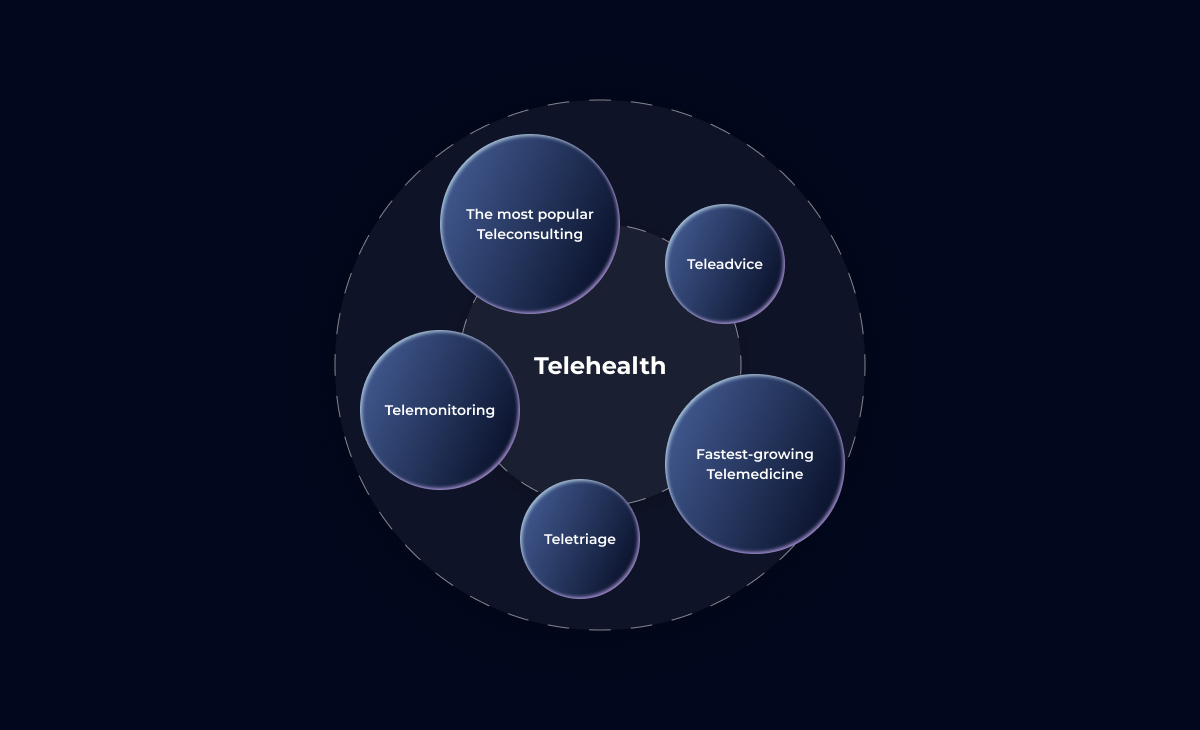
Veterinary telemedicine and telehealth in daily practice
Veterinarian-client-patient relationship (VCPR) and telehealth
Providing telemedicine services requires a veterinarian-client-patient relationship (VCPR) to be established and maintained. The VCPR rules were originally written as a guarantee that the veterinarian knows the pet well enough to provide care of acceptable quality. The rules slightly vary from state to state but the crucial points are all the same. AVMA offers a list of the local VCPR state laws as of November 2020.
So, for establishing the VCPR, the first pet appointment must be in-person. Then, the veterinarian must regularly examine the animal physically for maintaining the VCPR.
These rules apply to telemedicine and potentially to teletriage services. In other words, for determining the diagnosis and planning treatment, or prescribing a medication, the existing VCPR is obligatory. As a result, low-income clients and those who live in rural areas have less access to vet care.
The reasons for adhering to the VCPR in terms of telemedicine sound highly rational. But there is no cause for alarm, the Ontario experience shows. This Canadian state initially legalized the virtual VCPR. Then, during the COVID-19 pandemic, state veterinary medical associations allowed veterinarians to prescribe medications online. In just two months, 90 percent of veterinarians were providing telemedicine services. Since then, there have been no reported cases of adverse outcomes, such as misdiagnosis.
In conclusion, there is no evidence that allowing fully virtual VCPR (in other words, without the need for physical examination) leads to increased medical issues. This correlates to human telemedicine usage history where the virtual doctor-patient relation (DPR) has been legally established in 49 US states.
Increases competitiveness and boosts competition
Veterinary nurses and veterinarians have cleverly leveraged virtual visits to free up their schedules in order to spend more time on the more demanding cases and procedures that occur within the clinic and require their physical presence. Short and simple appointments that used to occur in person are now being relegated to the virtual space where they’re carried out much more efficiently for both clients and doctors.
Many clinics and hospitals are more commercially competitive as a result of this streamlining, which threatens the viability of those veterinary practices that refuse to embrace remote care and all of its benefits.
Veterinary care access becomes easier and cheaper
Remote communities, in particular, have also benefited from the widespread adoption of veterinary telemedicine. A virtual consultation makes it easier and less time-consuming for veterinary teams to provide the same care, potentially increasing the number of patients each employee can handle per shift. This makes virtual veterinary care significantly cheaper than in-person appointments.
Virtual care is also advantageous for large-animal patients such as horses. Owners can get the advice they need without the struggles of difficult or expensive transportation. Clinics which offer virtual vet visits may now be capable of penetrating remote rural areas.

Shows your customers you’re tech-savvy
In addition to removing barriers to veterinary healthcare, telehealth services allow practices to showcase their familiarity with cutting-edge technology. This is very important for attracting younger pet owners who are usually familiar with the new technologies and prefer receiving services online where it is possible.
This is what has helped the market recover after COVID-19
Ultimately, veterinary telemedicine serves as a booster shot for the animal healthcare sector as it recovers from a COVID-induced recession. Practices that remain open to innovative technologies will generally have an easier time accumulating market share in the post-COVID economy than those clinics which shun new ways of doing business.
Low- and high-risk cases in veterinary teleservices
While veterinary telemedicine stands to reshape much of daily practice, not every case can be handled from afar. Certain low-risk cases can be triaged and handled by experienced nurses. But more complicated cases that require a physical exam to fully assess the patient, require a procedure, or the expertise of many specialists should be handled in-clinic.
A survey conducted by a British The Royal College of Veterinary Surgeons, illustrates that veterinarians believe some elements of telemedicine are riskier than others. Virtually, every respondent to the RCVS review claimed that providing general advice remotely is a low-risk activity that clinics can engage in. Providing specific veterinary advice in relation to a particular animal proved more controversial, however, with a majority labeling it “medium risk.”
Below you can find a comparison of risks for the different veterinary telehealth services.

Getting started in veterinary telemedicine
Stepping into the field of veterinary telemedicine begins with defining the scope of virtual practice you wish to provide to clients. Determining which cases, questions, or patient problems you can solve virtually and which are best left for in-person consultations is a great first step.
Define your telehealth scope
Defining your scope begins by assessing the equipment you have at your disposal. Does your practice need to invest in higher-quality web cameras, microphones, and equipment like lighting instruments? Will your team require any outside training in order to host a virtual vet visit, or can your current workforce upskill any lingering Luddites?
Next, consider cases that could potentially be managed through telemedicine for your practice. Teletriage services where experienced veterinarians and nurses can tell at a glance or based on a thorough history, whether a patient needs an in-person consultation instead of virtual help are quite common.
Your practice may be able to leverage telehealth services in order to upskill its workforce. A teleconsultation between a virtual consulting veterinarian and an attending veterinarian in need of advice may produce ideal patient outcomes. Consider defining which cases absolutely need a veterinarian to be involved, and which can be handled by an experienced veterinary nurse.
Review state and industry guidelines
Remember that the game is always changing. That’s why it is crucial to be hands-on with the state regulations and industry standards and guidelines. The AVMA’s Model Veterinary Practice Act (MVPA) page may prove useful here, as well as VVCA’s veterinary telemedicine guides page.
Recruit your veterinary telemedicine team
Your current team may have a number of professionals who are ready and willing to embrace more virtual responsibilities who will free up other team members that are managing more traditional in-clinic duties. Creating an in-clinic and virtual care rotation for your team is an even better option.
Ask your nurses, technicians, and professionals across the board whether they’re interested in remote services. Reassure those who prefer doing business the old way that telemedicine won’t complicate their lives or add additional responsibilities, but instead, complement their workflows and make it easier to get home on time. Finally, consider recruiting specialized outside talents such as a triage team, or teleconsultation provider that’s onboarded to supercharge your telehealth offerings.
Train your customer service representatives for success
Your practice can’t achieve much if it’s saddled with unhappy customers. Teaching your customer service representatives (CSRs) how to identify cases that may be ideal for telemedicine will help prepare your entire organization for the shift toward digital services. Instructing any CSR on how to book online appointments while encouraging clients to do the same can get your practice started on the right foot.
Partner with insurance companies
Animal healthcare doesn’t have to be prohibitively expensive. Partnering with the insurance companies you’re already doing business with to facilitate teletriage and telemedicine services at scale may be necessary, especially for larger networks.
Providing your clients with guidance about paying for telehealth services in tandem with their insurance provider is also highly recommended. Remember that a majority of surveyed pet owners are happy to pay for veterinary telemedicine, though they may not always be familiar with changes to your payment system and could have some questions.
Establish your digital infrastructure
This may seem intimidating but mostly entails defining what you’ll need in order to accommodate virtual vet visits:
- Do you have a video conference platform that your professionals know how to navigate?
- Is your hardware in need of an upgrade?
- Do you have a more or less quiet area where your veterinary team members can interface with customers without interruption?
Sometimes this may entail relatively simple changes, such as upgrading your clinic’s internet plan to increase speed and improve connectivity.
Educate your clients
It takes two to tango, meaning that you must educate your clients on what to expect from veterinary telemedicine in order to achieve optimal patient outcomes. Make sure your clients understand:
- How to log on to your video conference platform
- How long the appointment will last
- How much they will have to pay
Remember to keep records
A telehealth veterinarian still has to keep medical records. Make sure that any online vet appointment or veterinary telemedicine offering has its own dedicated recordkeeping to ensure patient information or client preferences aren’t left by the wayside. It may be worth reminding your professional veterinary team that the recordkeeping practices they’re used to may need some minor adjustments in the age of digital teleconferencing.
Recommend you:
Episode: Telehealth Guiding to the Stars
Veterinary Practice Management 101
Veterinary Burnout Researched and Explained
Best Veterinary Conferences for 2022
Veterinary Practice Manager Salaries State-by-State
…and our other posts!
Veterinary telehealth providers
It’s easier to learn the ins and outs of veterinary telemedicine by learning about current providers who have already established a foothold in the marketplace.
Activ4Pets

Website: activ4pets.com
Services: health assessments, virtual consultation, free chat with a vet, second medical opinions, medical records
Pricing: pay-as-you-go, yearly memberships ($144 and $299)
Activ4Pets claims to “empower pet owners everywhere” by providing hassle-free online veterinary appointments that are advertised as time-saving and traffic-beating measures for busy pet owners. Remote consultations, labeled here as “eConsultations,” let patients connect with veterinarians via a webcam that can be used for diagnostics and other services.
Airvet

Website: airvet.com
Services: health assessments, virtual consultation, virtual emergency support, second medical opinions, prescription advice, life-saving emergency fund access
Pricing: $30 monthly membership fee
Airvet boasts of “affordable access to high-quality vet care” and offers pet owners access to up to $3,000 in a life-saving emergency fund under certain conditions. Airvet also offers coverage for pre-existing conditions and access to over 3,000 licensed vets for advice.
AskVet

Website: askvet.app
Services: custom personalized pet plans, daily guidance (e.g., pollen alerts), virtual consultation, 24/7 access to licensed veterinarians, membership in an online community of pet owners, rainy day fund of up to $1,000 under certain conditions
Pricing: $29.99 monthly membership fee
AskVet provides guidance for pet owners ranging from nutrition to health to daily behavior. Owners can easily consult with veterinarians to learn about vaccinations or prescriptions, and they can partake in an online community of pet owners who share advice often.
FetchaVet

Website: fetcha.vet
Services: search for nearby veterinarians by name, clinic, or keywords before reviewing and choosing your preference; online appointment booking, customer attraction tools for vets
Pricing: free service
FetchaVet helps pet owners identify nearby veterinary clinics and services with a free search service. Pet owners can find local experts by searching for names, clinics, or by using keywords to specify the kind of care they’re seeking.
GuardianVets

Website: guardianvets.com
Services: logistical support for veterinary care providers; on-call support for your practice, veterinary telemedicine, curbside care, book appointments via the app, remote staffing/virtual CSR, overflow calls, callback services, virtual CSR for emergency support
Pricing: varies per practice
GuardianVets serves clinics and hospital networks that are overwhelmed and in need of additional support. Overflow and callback services ensure quick responses to patient inquiries and virtual CSR emergency support helps you practice managing crises.
Pawp
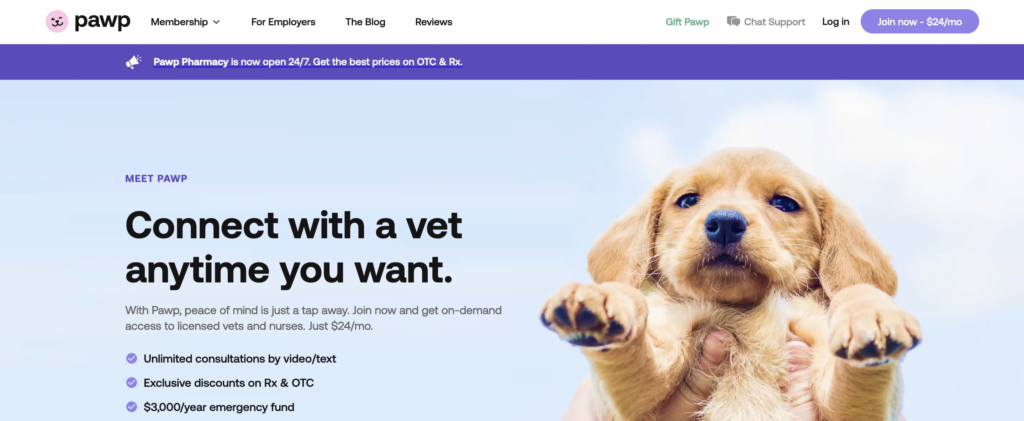
Website: pawp.com
Services: unlimited video calls or texts with veterinary experts, up to $3,000 in emergency rainy day funds under certain conditions, up to six pets per membership, risk-free cancellation policy
Pricing: $24 monthly membership fee
Pawp permits pet owners to enjoy unlimited virtual access to veterinary experts. Pawp also provides exclusive prices on Rx and OTC, with curated vet recommendations and a $3,000 emergency fund that can be accessed once per year.
PetDesk

Website: petdesk.com
Services: enhance patient connections, streamline communication, learning resources, team assistance for veterinary providers; pet insurance information, remote appointment requests, and pet health reminders for pet owners
Pricing: free service for pet owners, subscription rates vary for practices depending upon desired services
PetDesk supports veterinary practices by streamlining communications, digitizing their appointment systems, and providing learning resources and team assistance. PetDesk also provides services to pet owners, including information on pet insurance and pet health reminders.
PetProConnect
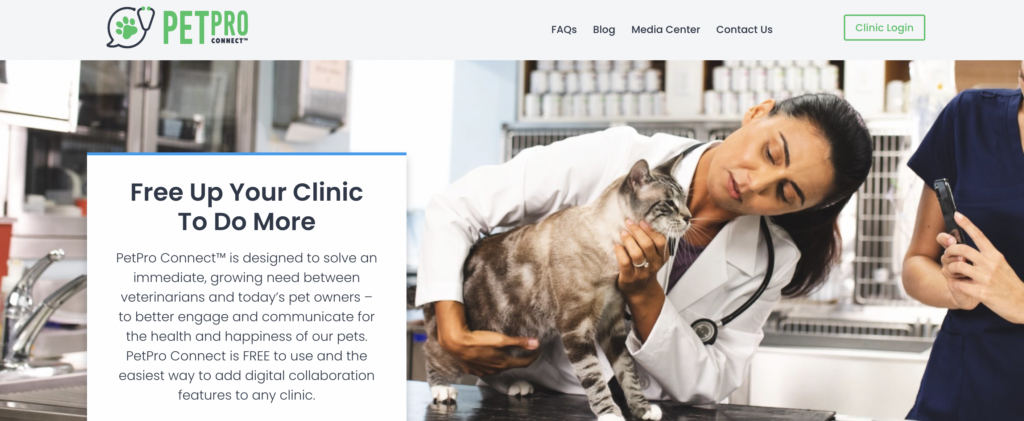
Website: petproconnect.com
Services: remote appointment requests, digital access to medical records, RX refills, telehealth services, pet owner rewards loyalty program, PIMs integration for practices, secure two-way messaging between pet owners and clinics
Pricing: no monthly fees, transaction fees temporarily waived at time of publishing
PetProConnect is a cloud-based product that helps clinics securely communicate with clients by managing patient scheduling, video appointments, and instant messaging. Their proprietary technology integrates into a clinic’s pre-existing practice management software and offers a complete suite of tools for modern veterinary operations.
Petzam
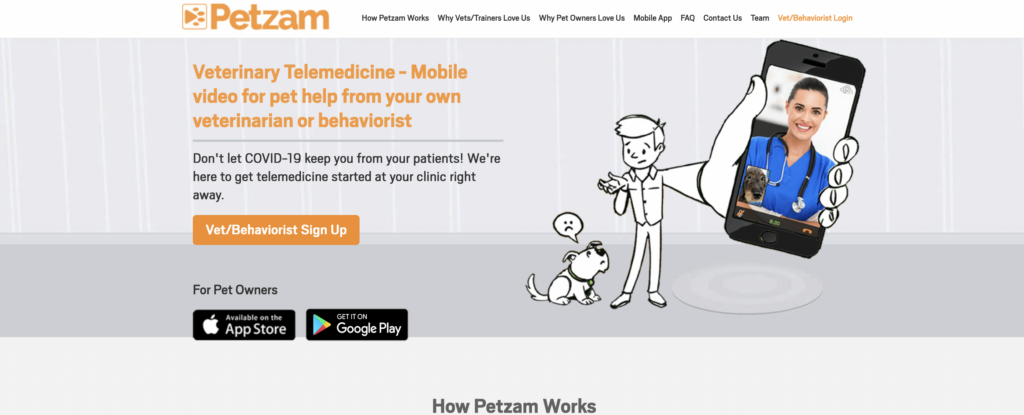
Website: petzam.com
Services: telemedicine services, live video chat with veterinary experts, payments directly through the app
Pricing: pet owners are charged per 10 minutes of the live video call, prices may vary
Petzam offers live video chats with veterinary experts who are part of the Petzam network. Petzam stresses its VCPR compliance and industry expertise when appealing to practice owners.
Telepaws
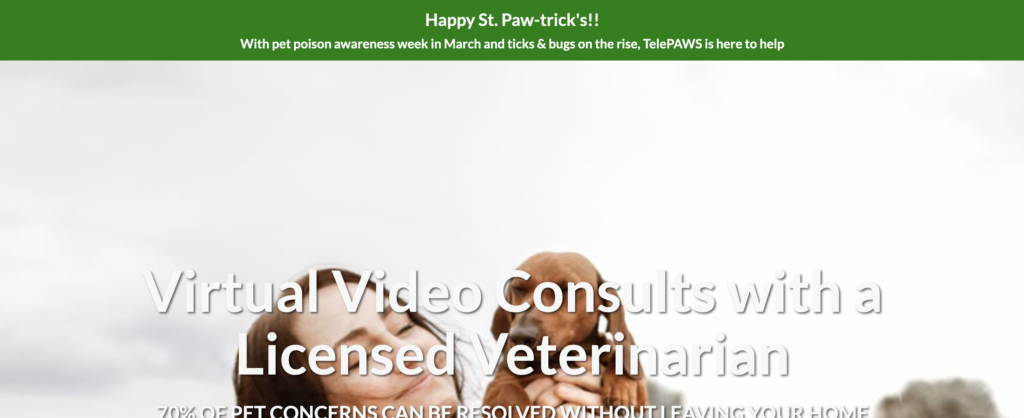
Website: telepaws.com
Services: telemedicine services, teletriage, live video consultations, non-urgent care, Rx support
Pricing: $19.99 monthly subscription fee
Telepaws offers live medical consultations, second medical opinions, behavioral guidance, referrals to veterinarians specializing in nutritional planning, and general advice to pet owners. A monthly subscription entitles members to six appointments per year with Telepaws veterinarians.
Teletails
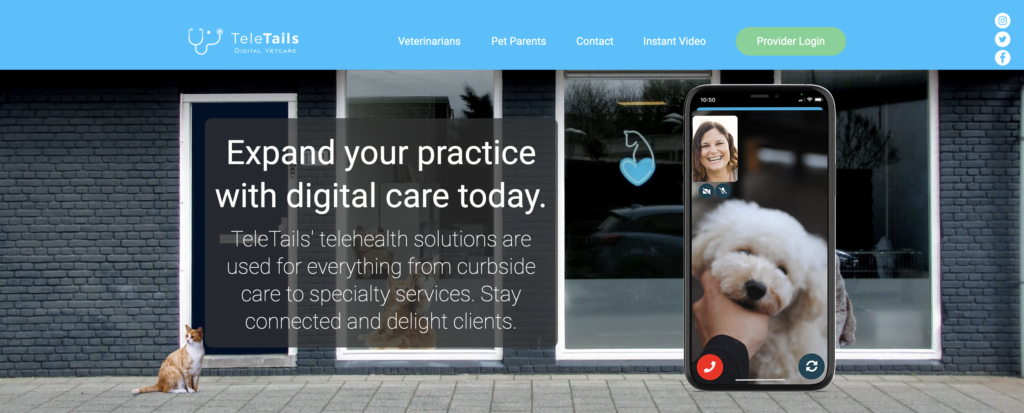
Website: teletails.com
Services: telemedicine platform to integrate workflows; live video, messaging, and payment services; digital consultations
Pricing: free to download the app
Teletails offers a telemedicine platform to veterinary providers in order to integrate workflows and streamline communication between patients and veterinarians. Digital consultations are also available for pet owners through the app.
Televet

Website: televet.com
Services: all-in-one telemedicine platform to manage scheduling, communication, and payments; two-way text and chat, patient check-in services, digital forms to eliminate wait times, video chats for remote veterinary care, automatic reminders for pet owners
Pricing: monthly subscription fee negotiated with Televet’s team upon sign-up
Televet lets providers communicate with clients from anywhere, send invoices with one click, manage clinic schedules and prescription requests, and offers unlimited appointments per clinic. Televet also integrates with pre-existing practice management software.
Vetster

Website: vetster.com
Services: telemedicine services, online appointment booking, identifying nearby veterinary experts, telemedicine news, a blog for pet owners.
Pricing: free to sign up, small platform usage fee charged per appointment booked via the app
Vetster provides a user-friendly platform for live telemedicine services and online appointment booking. Vetster also helps identify local veterinary experts and provides an informative blog for pet owners.
VitusVet

Website: vitusvet.com
Services: practice management software, contactless payment, automated reminders, digital medical records, provision of delivery or pickup options for medicine, pharmacy optimization
Pricing: $399 billed annually
VitusVet provides a suite of tools for practice management, with an emphasis on medical records, prescription assistance, and appointment booking. VitusVet also publishes an informative blog for pet owners.
WhiskerDocs

Website: whiskerdocs.com
Services: 24/7 telemedicine services, live call/chat services, complimentary follow-ups
Pricing: $129.99 billed annually for “unlimited plan” coverage, pricing options for one-time calls and emails vary
WhiskerDocs offers remote access to veterinary guidance 24 hours a day, 365 days of the year. In addition to providing teletriage services, WhiskerDocs provides complimentary follow-ups with pet owners after the fact.
A quote from Dr. Sarah Wallace, Head of Telemedicine at Galaxy Vets
Telemedicine is not currently widely used in our profession. In my opinion, this is probably because telehealth offerings are seen as yet another task that needs to be added on to the end of an already way-too-long workday. Or, if there is recognition of telemedicine’s potential for complementing one’s workflow, it isn’t obvious where, when, and how to start. If a plan is not made and one does not get buy-in from one’s team, the chances of successful integration of telemedicine into your workflows are low.
If you recognize that you have patients that really need to be seen that can’t get an appointment, then you may be overdue for some technological or process-related improvements. Telehealth is one such improvement for consideration.
Conclusion
Here are the key findings in a nutshell:
- Veterinary teleservices have huge potential of redefining access to care.
- The audiences with the greatest need are: low-income pet owners; pet owners who live in the rural areas; owners of large pets like horses; cat owners; owners of anxious pets; really any pet owner who has no time to wait for weeks for a veterinary appointment; younger and tech-savvy pet owners.
- The VCPR laws, initially instituted as defense measures, now act as an obstacle to teleservices, lead to increasing veterinary team workload, and lower access to care. That’s why they must be reformed.
- Even when the VCPR is established, there are strict limitations on the services can be risky without a physical examination.
- Several years of observation of the Ontario experience shows that the reformation of VCPR from physical to virtual hasn’t caused any issues. The same results were seen in human telemedicine.
- The role of telemedicine in the veterinary industry is to complement traditional in-person services, not to replace them.
- Implementation of virtual care must include a clear understanding of goals, thorough planning, and education of both veterinary teams and pet owners.
Pet owners expect animal healthcare services that meet their unique needs. In an era of social isolation and significant access to care barriers, meeting those needs entails investing in veterinary telehealth options that break down long-standing barriers to care and facilitate optimal patient outcomes despite an exhausted workforce.
Veterinary telemedicine cannot replace in-person treatment, nor can savvy digital tools serve as a substitute for years of experience. Nevertheless, digital services are opening up new markets, expanding current ones, and reshaping how veterinary professionals manage their daily responsibilities.
Those watching the veterinary industry have every reason to believe that some elements of veterinary telemedicine, like apps that offer video chats with professionals, are here to stay. Whether the veterinary companies take advantage of this technological revolution and help more pets than ever before will come down to how they devise their telehealth strategies.
Want to find more of our publications related to technologies in the veterinary industry? Check our Learning Center.


